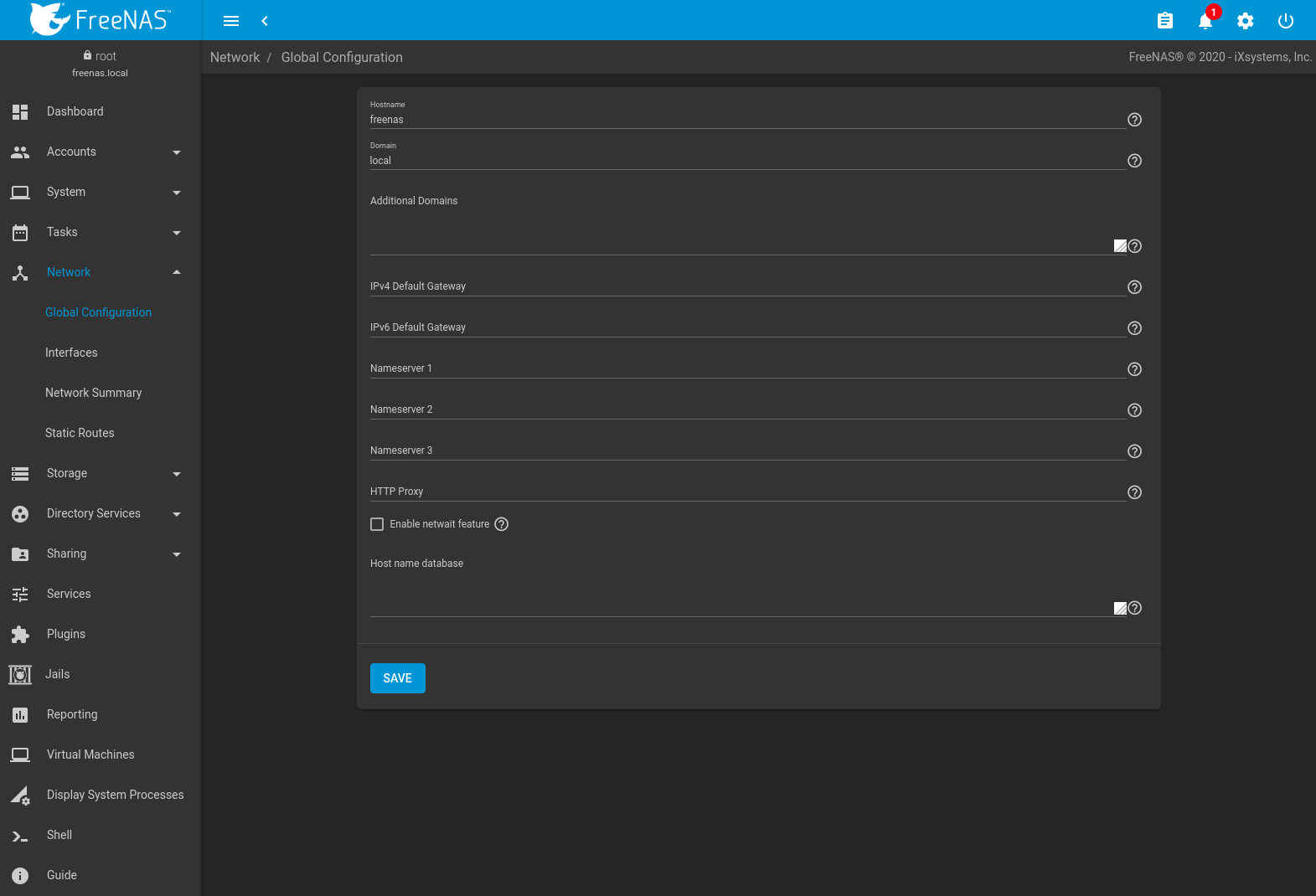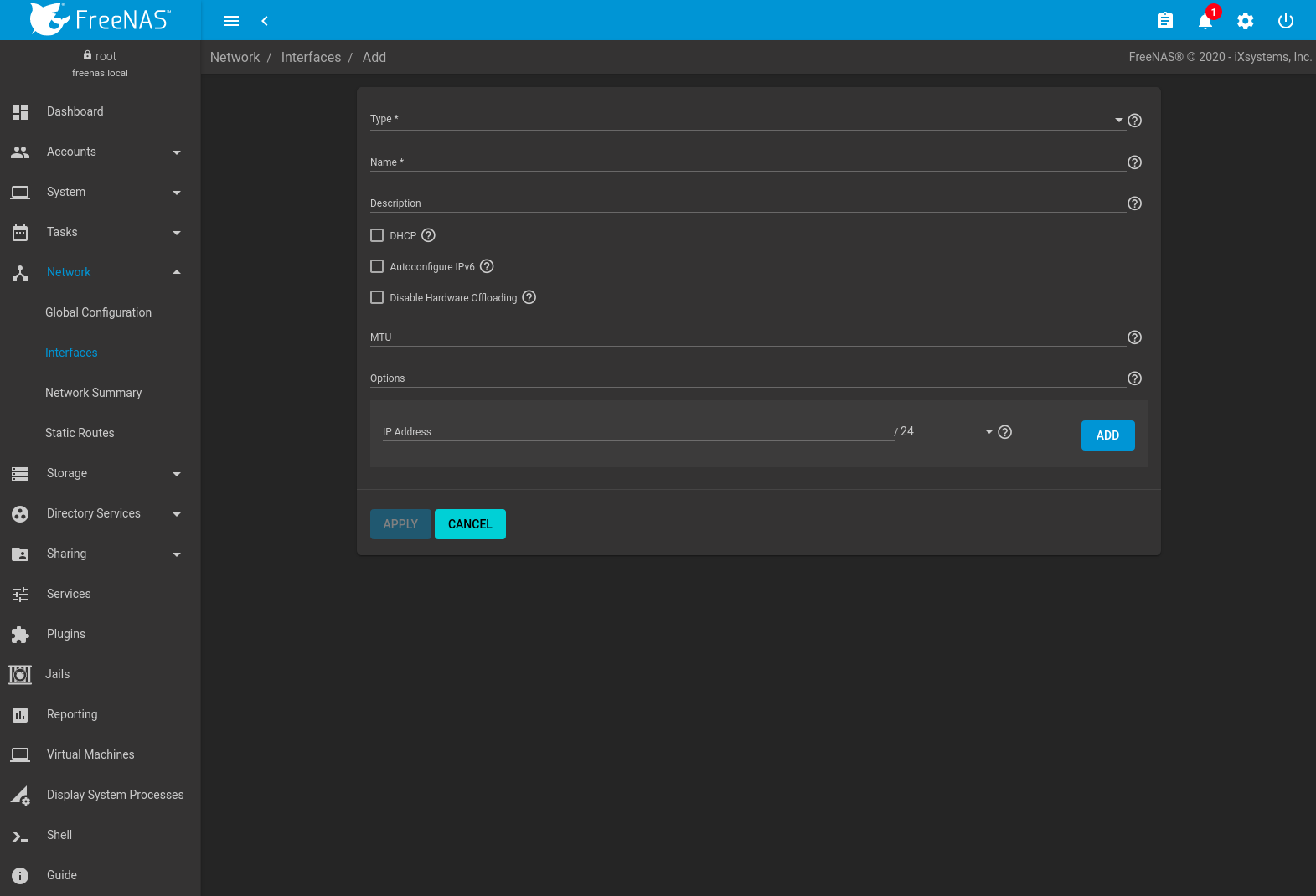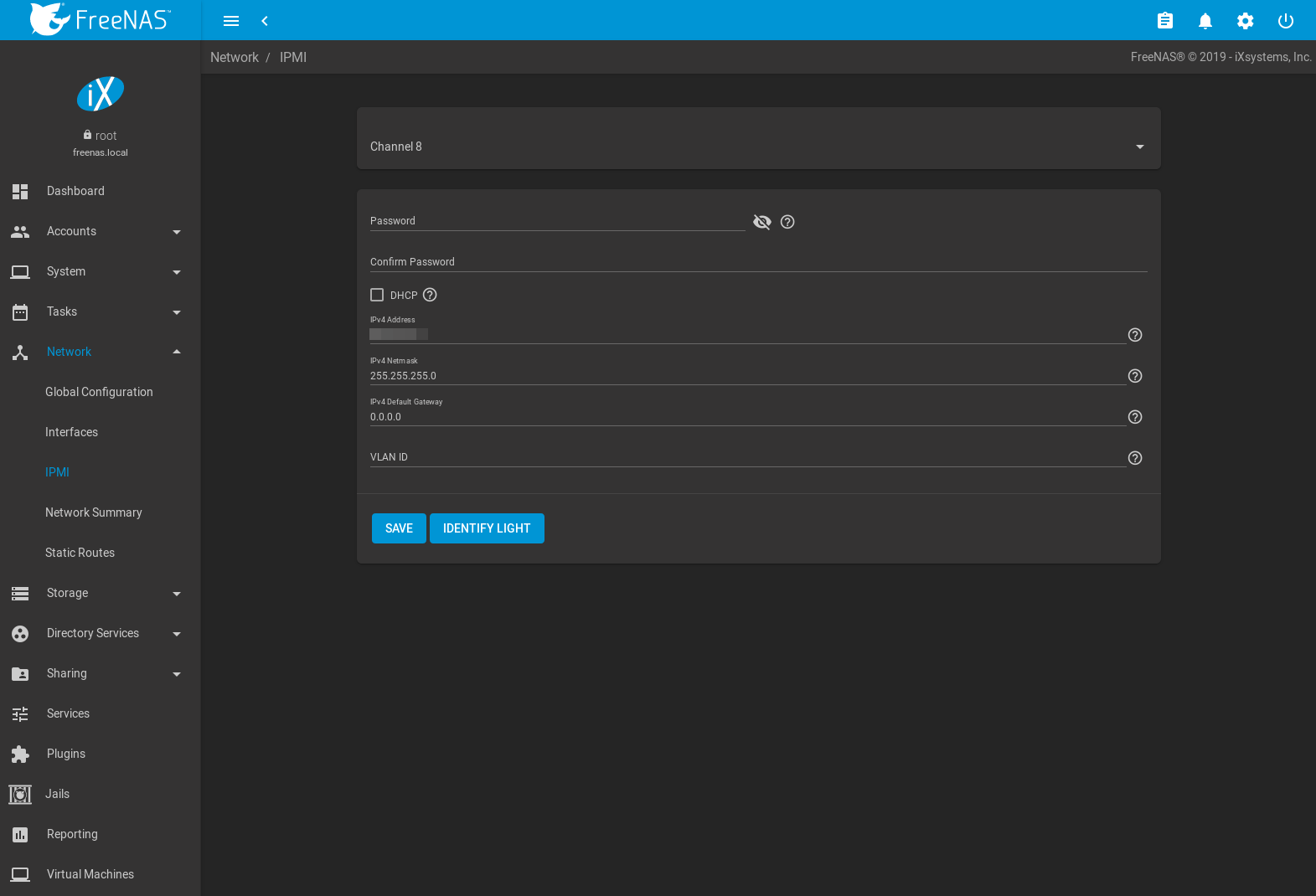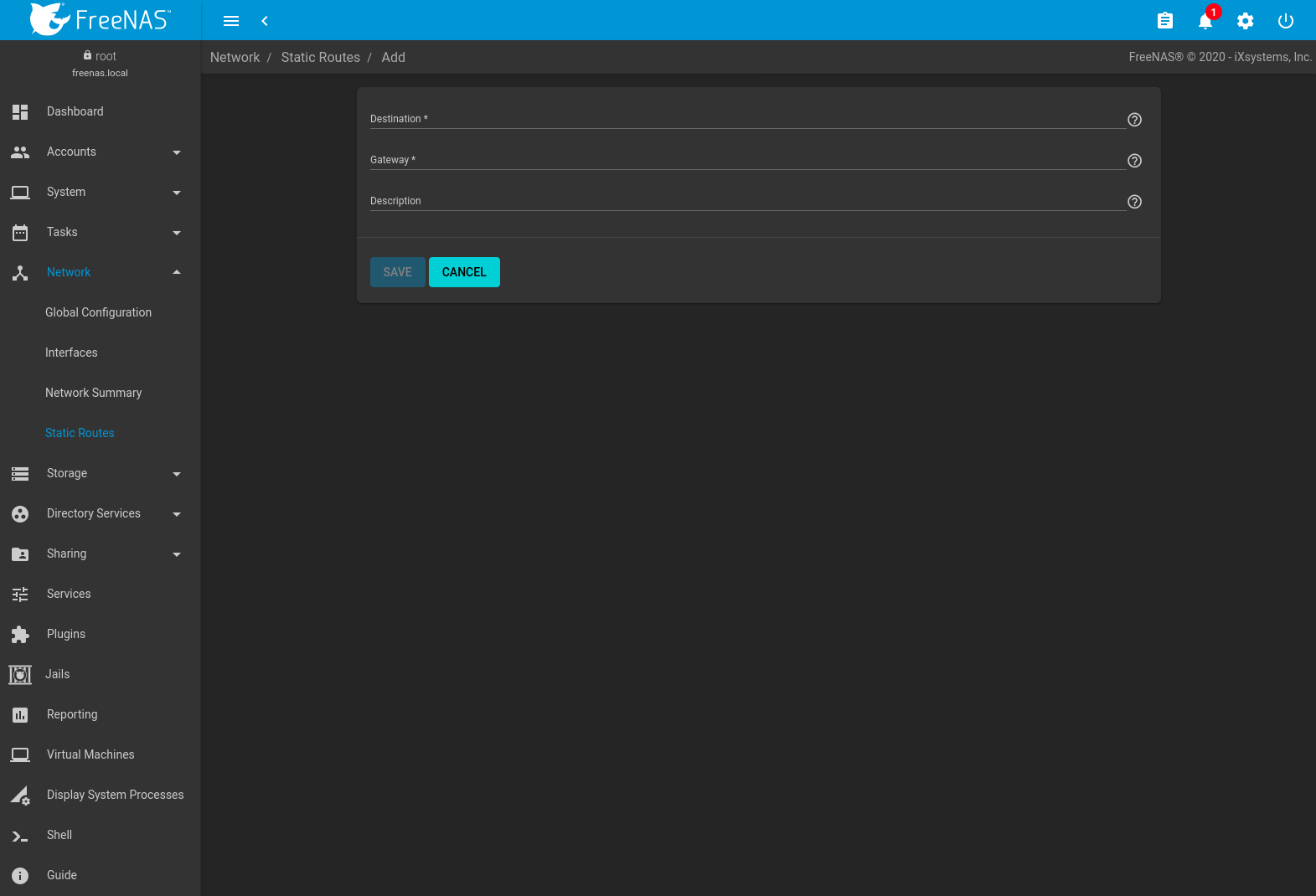9. Network¶
The Network section of the web interface contains these components for viewing and configuring network settings on the FreeNAS® system:
- Global Configuration: general network settings.
- Interfaces: settings for each network interface and options to configure Bridge, Link Aggregation, and VLAN interfaces.
- IPMI: settings controlling connection to the appliance through the hardware side-band management interface if the user interface becomes unavailable.
- Static Routes: add static routes.
Each of these is described in more detail in this section.
Note
When any network changes are made an animated icon appears in the upper-right web interface panel to show there are pending network changes. When the icon is clicked it prompts to review the recent network changes. Reviewing the network changes goes to where the changes can be permanently applied or discarded.
When APPLY CHANGES is clicked the network changes are temporarily applied for 60 seconds by default. This value can be changed by entering a positive integer in the seconds field. This feature is nice because the network settings preview can automatically roll back any configuration errors that are accidentally saved.
If the network settings applied work as intended, click KEEP CHANGES. Otherwise, the changes can be discarded by clicking DISCARD CHANGES.
9.1. Global Configuration¶
, shown in Figure 9.1.1, is for general network settings that are not unique to any particular network interface.

Fig. 9.1.1 Global Network Configuration
Table 9.1.1 summarizes the settings on the Global Configuration tab. Hostname and Domain fields are pre-filled as shown in Figure 9.1.1, but can be changed to meet requirements of the local network.
| Setting | Value | Description |
|---|---|---|
| Hostname | string | System host name. Upper and lower case alphanumeric, ., and -
characters are allowed. The Hostname and Domain are also displayed
under the iXsystems logo at the top left of the main screen. |
| Domain | string | System domain name. The Hostname and Domain are also displayed under the iXsystems logo at the top left of the main screen. |
| Additional Domains | string | Additional space-delimited domains to search. Adding search domains can cause slow DNS lookups. |
| IPv4 Default Gateway | IP address | Typically not set. See this note about Gateways. If set, used instead of the default gateway provided by DHCP. |
| IPv6 Default Gateway | IP address | Typically not set. See this note about Gateways. |
| Nameserver 1 | IP address | Primary DNS server. |
| Nameserver 2 | IP address | Secondary DNS server. |
| Nameserver 3 | IP address | Tertiary DNS server. |
| HTTP Proxy | string | Enter the proxy information for the network in the format http://my.proxy.server:3128 or http://user:password@my.proxy.server:3128. |
| Enable netwait feature | checkbox | If enabled, network services do not start at boot until the interface is able to ping the addresses listed in the Netwait IP list. |
| Netwait IP list | string | Only appears when Enable netwait feature is set. Enter a space-delimited list of IP addresses to ping(8). Each address is tried until one is successful or the list is exhausted. Leave empty to use the default gateway. |
| Host name database | string | Used to add one entry per line which will be appended to /etc/hosts. Use the format
IP_address space hostname where multiple hostnames can be used if separated by a space. |
When using Active Directory, set the IP address of the realm DNS server in the Nameserver 1 field.
If the network does not have a DNS server, or NFS, SSH, or FTP users are receiving “reverse DNS” or timeout errors, add an entry for the IP address of the FreeNAS® system in the Host name database field.
Note
In many cases, a FreeNAS® configuration does not include default gateway information as a way to make it more difficult for a remote attacker to communicate with the server. While this is a reasonable precaution, such a configuration does not restrict inbound traffic from sources within the local network. However, omitting a default gateway will prevent the FreeNAS® system from communicating with DNS servers, time servers, and mail servers that are located outside of the local network. In this case, it is recommended to add Static Routes to be able to reach external DNS, NTP, and mail servers which are configured with static IP addresses. When a gateway to the Internet is added, make sure the FreeNAS® system is protected by a properly configured firewall.
9.2. Interfaces¶
shows all physical Network Interface Controllers (NICs) connected to the FreeNAS® system. These can be edited or new bridge, link aggregation, or Virtual LAN (VLAN) interfaces can be created and added to the interface list.
Be careful when configuring the network interface that controls the FreeNAS® web interface or web connectivity can be lost.
To configure a new network interface, go to and click ADD.

Fig. 9.2.1 Adding a Network Interface
Each Type of configurable network interface changes the available options. Table 9.2.1 shows which settings are available with each interface type.
| Setting | Value | Type | Description |
|---|---|---|---|
| Type | drop-down menu | All | Choose the type of interface. Bridge creates a logical link between multiple networks. Link Aggregation combines multiple network connections into a single interface. A virtual LAN (VLAN) partitions and isolates a segment of the connection. |
| Name | string | All | Enter a name to use for the the interface. Use the format laggX, vlanX, or bridgeX where X is a number representing a non-parent interface. |
| Description | string | All | Notes or explanatory text about this interface. |
| DHCP | checkbox | All | Enable DHCP to auto-assign an IPv4 address to this interface. Leave unset to create a static IPv4 or IPv6 configuration. Only one interface can be configured for DHCP. |
| Autoconfigure IPv6 | drop-down menu | All | Automatically configure the IPv6 address with rtsol(8). Only one interface can be configured this way. |
| Disable Hardware Offloading | checkbox | All | Turn off hardware offloading for network traffic processing. WARNING: disabling hardware offloading can reduce network performance and is only recommended when the interface is managing jails, plugins, or virtual machines (VMs). |
| Bridge Members | drop-down menu | Bridge | Network interfaces to include in the bridge. |
| Lagg Protocol | drop-down menu | Link Aggregation | Select the Protocol Type. LACP is the recommended protocol if the network switch is capable of active LACP. Failover is the default protocol choice and should only be used if the network switch does not support active LACP. |
| Lagg Interfaces | drop-down menu | Link Aggregation | Select the interfaces to use in the aggregation. Warning: Lagg creation fails when the selected interfaces have manually assigned IP addresses. |
| Parent Interface | drop-down menu | VLAN | Select the VLAN Parent Interface. Usually an Ethernet card connected to a switch port configured for the VLAN. A bridge cannot be selected as a parent interface. New Link Aggregations are not available until the system is restarted. |
| Vlan Tag | integer | VLAN | The numeric tag provided by the switched network. |
| Priority Code Point | drop-down menu | VLAN | Select the Class of Service. The available 802.1p Class of Service ranges from Best effort (default) to Network control (highest). |
| MTU | integer | All | Maximum Transmission Unit, the largest protocol data unit that can be communicated. The largest workable MTU size varies with network interfaces and equipment. 1500 and 9000 are standard Ethernet MTU sizes. Leaving blank restores the field to the default value of 1500. |
| Options | string | All | Additional parameters from ifconfig(8). Separate multiple parameters with a space. For example: mtu 9000 increases the MTU for interfaces which support jumbo frames. See this note about MTU and lagg interfaces. |
| IP Address | integer and drop-down menu | All | Static IPv4 or IPv6 address and subnet mask. Example: 10.0.0.3 and /24. Click ADD to add another IP address. Clicking DELETE removes that IP Address. |
Multiple interfaces cannot be members of the same subnet. See Multiple network interfaces on a single subnet for more information. Check the subnet mask if an error is shown when setting the IP addresses on multiple interfaces.
Saving a new interface adds an entry to the list in .
Expanding an entry in the list shows further details for that interface.
Editing an interface allows changing all the interface options except the interface Type and Name.
9.2.1. Network Bridges¶
A network bridge allows multiple network interfaces to function as a single interface.
To create a bridge, go to and click ADD. Choose Bridge as the Type and continue to configure the interface. See the Interface Configuration Options table for descriptions of each option.
Enter bridgeX for the Name, where X is a unique
interface number. Open the Bridge Members drop-down menu and
select each interface that will be part of the bridge. Click
SAVE to add the new bridge to
and show options to confirm or revert the new network settings.
9.2.2. Link Aggregations¶
FreeNAS® uses the FreeBSD lagg(4) interface to provide link aggregation and link failover support. A lagg interface allows combining multiple network interfaces into a single virtual interface. This provides fault-tolerance and high-speed multi-link throughput. The aggregation protocols supported by lagg both determines the ports to use for outgoing traffic and if a specific port accepts incoming traffic. The link state of the lagg interface is used to validate whether the port is active.
Aggregation works best on switches supporting LACP, which distributes traffic bi-directionally while responding to failure of individual links. FreeNAS® also supports active/passive failover between pairs of links. The LACP and load-balance modes select the output interface using a hash that includes the Ethernet source and destination address, VLAN tag (if available), IP source and destination address, and flow label (IPv6 only). The benefit can only be observed when multiple clients are transferring files from the NAS. The flow entering into the NAS depends on the Ethernet switch load-balance algorithm.
The lagg driver currently supports several aggregation protocols, although only Failover is recommended on network switches that do not support LACP:
Failover: the default protocol. Sends traffic only through the active port. If the master port becomes unavailable, the next active port is used. The first interface added is the master port. Any interfaces added later are used as failover devices. By default, received traffic is only accepted when received through the active port. This constraint can be relaxed, which is useful for certain bridged network setups, by going to and clicking ADD to add a tunable. Set the Variable to net.link.lagg.failover_rx_all, the Value to a non-zero integer, and the Type to Sysctl.
LACP: supports the IEEE 802.3ad Link Aggregation Control Protocol (LACP) and the Marker Protocol. LACP negotiates a set of aggregable links with the peer into one or more link aggregated groups (LAGs). Each LAG is composed of ports of the same speed, set to full-duplex operation. Traffic is balanced across the ports in the LAG with the greatest total speed. In most situations there will be a single LAG which contains all ports. In the event of changes in physical connectivity, link aggregation quickly converges to a new configuration. LACP must be configured on the network switch and LACP does not support mixing interfaces of different speeds. Only interfaces that use the same driver, like two igb ports, are recommended for LACP. Using LACP for iSCSI is not recommended as iSCSI has built-in multipath features which are more efficient.
Note
When using LACP, verify the switch is configured for active LACP. Passive LACP is not supported.
Load Balance: balances outgoing traffic across the active ports based on hashed protocol header information and accepts incoming traffic from any active port. This is a static setup and does not negotiate aggregation with the peer or exchange frames to monitor the link. The hash includes the Ethernet source and destination address, VLAN tag (if available), and IP source and destination address. Requires a switch which supports IEEE 802.3ad static link aggregation.
Round Robin: distributes outgoing traffic using a round-robin scheduler through all active ports and accepts incoming traffic from any active port. This mode can cause unordered packet arrival at the client. This has a side effect of limiting throughput as reordering packets can be CPU intensive on the client. Requires a switch which supports IEEE 802.3ad static link aggregation.
None: this protocol disables any traffic without disabling the lagg interface itself.
9.2.2.1. LACP, MPIO, NFS, and ESXi¶
LACP bonds Ethernet connections to improve bandwidth. For example, four physical interfaces can be used to create one mega interface. However, it cannot increase the bandwidth for a single conversation. It is designed to increase bandwidth when multiple clients are simultaneously accessing the same system. It also assumes that quality Ethernet hardware is used and it will not make much difference when using inferior Ethernet chipsets such as a Realtek.
LACP reads the sender and receiver IP addresses and, if they are deemed to belong to the same TCP connection, always sends the packet over the same interface to ensure that TCP does not need to reorder packets. This makes LACP ideal for load balancing many simultaneous TCP connections, but does nothing for increasing the speed over one TCP connection.
MPIO operates at the iSCSI protocol level. For example, if four IP addresses are created and there are four simultaneous TCP connections, MPIO will send the data over all available links. When configuring MPIO, make sure that the IP addresses on the interfaces are configured to be on separate subnets with non-overlapping netmasks, or configure static routes to do point-to-point communication. Otherwise, all packets will pass through one interface.
LACP and other forms of link aggregation generally do not work well with virtualization solutions. In a virtualized environment, consider the use of iSCSI MPIO through the creation of an iSCSI Portal with at least two network cards on different networks. This allows an iSCSI initiator to recognize multiple links to a target, using them for increased bandwidth or redundancy. This how-to contains instructions for configuring MPIO on ESXi.
NFS does not understand MPIO. Therefore, one fast interface is needed, since creating an iSCSI portal will not improve bandwidth when using NFS. LACP does not work well to increase the bandwidth for point-to-point NFS (one server and one client). LACP is a good solution for link redundancy or for one server and many clients.
9.2.2.2. Creating a Link Aggregation¶
Before creating a link aggregation, see this warning about changing the interface that the web interface uses.
To create a link aggregation, go to and click ADD. Choose Link Aggregation as the Type and continue to fill in the remaining configuration options. See the Interface Configuration Options table for descriptions of each option.
Enter laggX for the Name, where X is a unique
interface number. There a several Lagg Protocol options, but
LACP is preferred. Choose Failover when the network switch does not
support LACP. Open the Lagg Interfaces drop-down menu to
associate NICs with the lagg device. Click SAVE to add the
new aggregation to
and show options to confirm or revert the new network settings.
Note
If interfaces are installed but do not appear in the Lagg Interfaces list, check for a FreeBSD driver for the interface.
9.2.2.3. Link Aggregation Options¶
Options are set at the lagg level from . Find the lagg interface, expand the entry with (Expand), and click EDIT. Scroll to the Options field. Changes are typically made at the lagg level as each interface member inherits settings from the lagg. Configuring at the interface level requires repeating the configuration for each interface within the lagg. Setting options at the individual interface level is done by editing the parent interface in the same way as the lagg interface.
If the MTU settings on the lagg member interfaces are not identical, the smallest value is used for the MTU of the entire lagg.
Note
A reboot is required after changing the MTU to create a jumbo frame lagg.
Link aggregation load balancing can be tested with:
systat -ifstat
More information about this command can be found at systat(1).
9.2.3. VLANs¶
FreeNAS® uses vlan(4) to demultiplex frames with IEEE 802.1q tags. This allows nodes on different VLANs to communicate through a layer 3 switch or router. A vlan interface must be assigned a parent interface and a numeric VLAN tag. A single parent can be assigned to multiple vlan interfaces provided they have different tags.
Note
VLAN tagging is the only 802.1q feature that is implemented. Additionally, not all Ethernet interfaces support full VLAN processing. See the HARDWARE section of vlan(4) for details.
To add a new VLAN interface, go to and click ADD. Choose VLAN as the Type and continue filling in the remaining fields. See the Interface Configuration Options table for descriptions of each option.
The parent interface of a VLAN must be up, but it can either have an IP address or be unconfigured, depending upon the requirements of the VLAN configuration. This makes it difficult for the web interface to do the right thing without trampling the configuration. To remedy this, add the VLAN interface, then select , and click (Options) and Edit for the parent interface. Enter up in the Options field and click SAVE. This brings up the parent interface. If an IP address is required, configure it using the rest of the options in the edit screen.
Warning
Creating a VLAN causes an interruption to network connectivity. The web interface requires confirming the new network configuration before it is permanently applied to the FreeNAS® system.
9.3. IPMI¶
Beginning with version 9.2.1, FreeNAS® provides a graphical screen for configuring an IPMI interface. This screen will only appear if the system hardware includes a Baseboard Management Controller (BMC).
IPMI provides side-band management if the graphical administrative interface becomes unresponsive. This allows for a few vital functions, such as checking the log, accessing the BIOS setup, and powering on the system without requiring physical access to the system. IPMI is also used to give another person remote access to the system to assist with a configuration or troubleshooting issue. Before configuring IPMI, ensure that the management interface is physically connected to the network. The IPMI device may share the primary Ethernet interface, or it may be a dedicated separate IPMI interface.
Warning
It is recommended to first ensure that the IPMI has been patched against the Remote Management Vulnerability before enabling IPMI. This article provides more information about the vulnerability and how to fix it.
Note
Some IPMI implementations require updates to work with newer versions of Java. See PSA: Java 8 Update 131 breaks ASRock’s IPMI Virtual console for more information.
IPMI is configured from . The IPMI configuration screen, shown in Figure 9.3.1, provides a shortcut to the most basic IPMI configuration. Those already familiar with IPMI management tools can use them instead. Table 9.3.1 summarizes the options available when configuring IPMI with the FreeNAS® web interface.

Fig. 9.3.1 IPMI Configuration
| Setting | Value | Description |
|---|---|---|
| Channel | drop-down menu | Select the communications channel to use. Available channel numbers vary by hardware. |
| Password | string | Enter the password used to connect to the IPMI interface from a web browser. The maximum length accepted in the UI is 20 characters, but different hardware might require shorter passwords. |
| DHCP | checkbox | If left unset, IPv4 Address, IPv4 Netmask, and Ipv4 Default Gateway must be set. |
| IPv4 Address | string | IP address used to connect to the IPMI web interface. |
| IPv4 Netmask | drop-down menu | Subnet mask associated with the IP address. |
| IPv4 Default Gateway | string | Default gateway associated with the IP address. |
| VLAN ID | string | Enter the VLAN identifier if the IPMI out-of-band management interface is not on the same VLAN as management networking. |
| IDENTIFY LIGHT | button | Show a dialog to activate an IPMI identify light on the compatible connected hardware. |
After configuration, the IPMI interface is accessed using a web browser and the IP address specified in the configuration. The management interface prompts for a username and the configured password. Refer to the IPMI device documentation to determine the default administrative username.
After logging in to the management interface, the default administrative username can be changed, and additional users created. The appearance of the IPMI utility and the functions that are available vary depending on the hardware.
9.4. Network Summary¶
shows a quick summary of the addressing information of every configured interface. For each interface name, the configured IPv4 and IPv6 addresses, default routes, and DNS namerservers are displayed.
9.5. Static Routes¶
No static routes are defined on a default FreeNAS® system. If a static route is required to reach portions of the network, add the route by going to , and clicking ADD. This is shown in Figure 9.5.1.

Fig. 9.5.1 Adding a Static Route
The available options are summarized in Table 9.5.1.
| Setting | Value | Description |
|---|---|---|
| Destination | integer | Use the format A.B.C.D/E where E is the CIDR mask. |
| Gateway | integer | Enter the IP address of the gateway. |
| Description | string | Optional. Add any notes about the route. |
Added static routes are shown in . Click (Options) on a route entry to access the Edit and Delete buttons.